Back to Native American art and attribution (please see here and here, if you are new to this subject):
I was interested in this topic because I do think that attaching the name of an individual artist to an Indian “specimen” or “artifact” will elevate it squarely into “art.” As Kate C. Duncan, a professor at Arizona State University said, “if a museum says it’s art, it’s art.”
Â
Part of our reluctance, over the years, to call Native American objects “art” can be explained this way: “We tend to think that if you’re a true artist, you do what no one else does,” Duncan said. “With Native Americans, the common cultural system functions differently. It’s not the individual, it’s the individual within the group. What’s important is the group’s survival.” Some contemporary Indian artists prefer to call themselves “a maker,” rather than “an artist,” Duncan added. “Artist is a European construct.”
Â
And of course, I knew that, as a few commenters here and on The New York Times website have done, some would raise the issue of whether it is appropriate to attribute individual names to these works — whether we were simply, and wrongly, applying today’s individualism to ancient peoples.
Â
Duncan, a former head of the Native American Art Studies Association who does attribution research, agreed that it is problematic: “It is trying to put a Western construct on a different culture,” she said.Â
Yet others told me that the prevalent view that Indian culture is a collective culture, not about the individual, is overdrawn. Some tribes had artist “classes,” even artists guilds. They and their skills were valued. Â
Then, too, as Valerie Verzuh, a curator at the Museum of Indian Arts and Culture in Santa Fe, told me, regarding attribution, “It’s part of humanizing the collection. These are not just abstract objects; they are the work of individuals, of members of a family, of members of a pueblo.”
At the end of the day, I decided that this is the right thing to do — now.
Interestingly, I focused on museums for the article, but late Sunday I received an email from John Molloy, a dealer who advises Christie’s on Native American art.
I agree with you that identifying the artists by name is part of the process whereby the western world identifies the work as art. In the Native American auction at Christie’s two weeks ago, we made a conscious effort to identify and write about the individual artists.
He pointed me to the catalogue of Jan. 18 sale, and sure enough, inside are attributions to, and short items about, Wahnomkot (also known as Maggie Aida Icho), who died in 1964; Wilson Tewaquaptewa, 1871-1960; Iris Nampeyo, 1860-1942, plus several more recent Native American artists that sign their work.Â
Molloy also provided me with an idea for the image I’ve used above. He wrote:Â
[It] is currently on view in the exhibition at the DenverArt Museum. Dating to the first part of the eighteenth century, it is the only extant example of its type.It showed up about twenty years ago in a general antique auction without any history, much less any reference to its maker which highlights some of the difficulties inherent.After spending some 250 years who-knows-where in France, it now will be housed in American museums hopefully at least as long. But we will never know who made it more than a tentative tribal attribution.
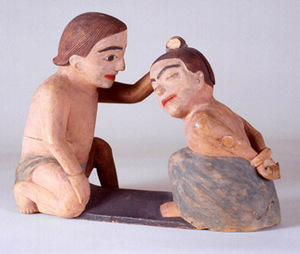 The description in the catalogue is “Painted Hide Shirt, Great Lakes Region, First Half 18th Century.” The image here doesn’t do it justice, btw. Estimated at $250,000 to $300,000, it fetched $362,500, including the buyer’s premium.
The description in the catalogue is “Painted Hide Shirt, Great Lakes Region, First Half 18th Century.” The image here doesn’t do it justice, btw. Estimated at $250,000 to $300,000, it fetched $362,500, including the buyer’s premium.
Now is a time for throwing out another wrinkle in the story. I kept wondering why so few people have paid attention to attribution work, and why so few have done it. I know it’s tedious, but wouldn’t it be fun to discover “new” artists, to find a name to match a “master of…”?
One theory I heard was this: just as attribution research was gathering steam 30-plus years ago, along came what, for better or for worse, people call the politicization of art history. It was suddenly ok to connect art to social history, to view art through a gender lens, or through a political lens, and so on. And that was much more popular, more fun, extinguishing enthusiasm for attribution research.
True? I don’t know — I tried that out on a couple of other people and they disagreed, blaming the lack of interest more on the need for patience and years of work.
And, maybe, on subsequent corrections — as information in this area changes and revisions are required. One example: The Denver museum has owned a headdress, acquired in 1948, that was originally identified as a Tlingit or Bella Coola (now Nuxalk) piece. Twenty years later, it was relabeled as a Haida work and later still attributed to Albert Edward Edenshaw. So it changed over the course of 30 years from being attributed to the wrong tribe, to the right tribe, and finally to an artist.
Here’s another example, from the Hearst Museum at Berkeley, about Man Torturing A Witch (above):
Art historian Bill Holm has pioneered the attribution of otherwise anonymous Haida artifacts. This carving and the two masks were originally attributed by Holm to John Gwaytihl (ca. 1822-1912), but based on further information, his student Robin Wright has attributed them to Simeon Stilthda. Possibly related, the two artists lived in the same community and must have worked together.
Finally, one observation, which I believe to be true, from dealer Donald Ellis: Advances in computer technology, which allows the superimposition of images, has helped attribution research recently.Â
And it will do more so in the future. I hope.
Photo Credits: Courtesy of Christie’s (top); Hearst Museum (bottom). Â

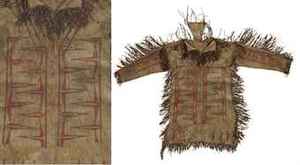
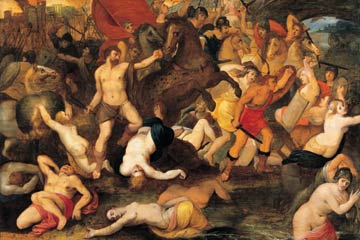 What makes the collection all the more interesting, according to the British press, is that many of the pictures, cleaned and restored in preparation for the show and a catalogue, tell new art-historical tales.
What makes the collection all the more interesting, according to the British press, is that many of the pictures, cleaned and restored in preparation for the show and a catalogue, tell new art-historical tales.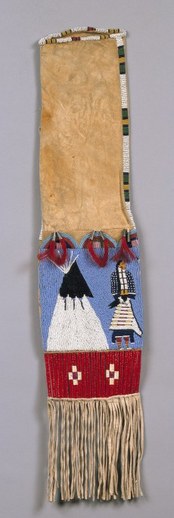 Hence this post. The attribution research movement, if I may call it that, fascinates me. It began decades ago, and by now should have had a far bigger impact on museums.Â
Hence this post. The attribution research movement, if I may call it that, fascinates me. It began decades ago, and by now should have had a far bigger impact on museums. 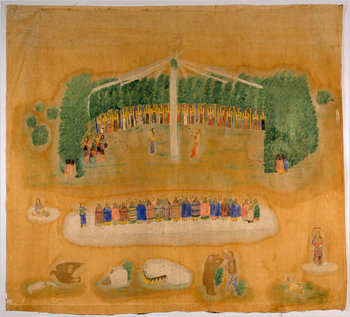
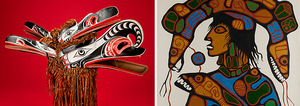
 Police reportedly seized 30 works of art from the
Police reportedly seized 30 works of art from the